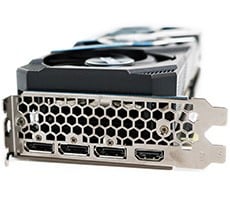NVIDIA GeForce 8800 GTX and 8800 GTS: Unified Powerhouses
After reading through the architectural details and new features found in the G80, we're sure you're all wondering what the GeForce 8800 GTX and 8800 GTS cards actually looks like, so without further ado we present to you the GeForce 8800 GTX...
NVIDIA's new flagship graphics card is a beast in every sense of the word. The card is built upon a 10.5" long PCB and the GPU and RAM are adorned with a massive dual-slot cooling apparatus. The cooler is outfitted with a fan that is designed to draw air in from the back, and blow it across the heatsink's fins, where is it ultimately expelled from the system through vents in the case bracket. There are however, some vents cut in the fan shroud towards the front of the card, which also aid in bringing temperatures down.
The 8800 GTX reference specifications call for a G80 GPU clocked at 575MHz with 768MB of RAM clocked at 1.8GHz. Due to the GTX's 384-bit memory bus, cards are equipped with 12, 32-bit DRAM chips, which all reside on the front side of the PCB.
Another interesting aspect with regard to the PCB is that it has two SLI edge connectors along the top. NVIDIA hasn't disclosed any specific information about what the second SLI connector could be used for, but when we asked about it, we did receive this response:
"The second SLI connector on the GeForce 8800 GTX is hardware support for potential future enhancements in our SLI software functionality. With the current drivers, only one SLI connector is actually used. Users can plug the SLI connector into either the right or left set of SLI fingers."
The GeForce 8800 GTX is also equipped with a pair of 6-Pin PCI Express power receptacles. Overall, NVIDIA has stated the 8800 GTX consumes a maximum of 185W, and the company recommends a 450W PSU that can supply 30A on its 12V rails.
With the cooler removed, the large G80 GPU is exposed, along with a second ASIC behind the DVI outputs. For GeForce 8800 GPUs, NVIDIA decided to put the TMDS and other display logic into a custom, discrete ASIC. This was done to simplify package and board routing as well as for manufacturing efficiencies. While on the subject of display logic, we should also mention that GeForce 8800 GTX cards have dual, dual-link DVI outputs in addition to an TV/HD output.
We also received a couple of retail-ready GeForce 8800 GTX cards prior to launch and wanted to showcase them for you here.
Leadtek's GeForce 8800 GTX conforms to NVIDIA's reference specifications in virtually every way. Underneath the custom fan shroud decal is a card identical to the one pictured above. Leadtek will be bundling their GeForce 8800 GTX card with an assortment of software and accessories that includes a pair of PCI Express power adapters, a DVI to DB15 VGA adapter, an HD component output dongle, a user's manual and installation guide, and a variety of software on CDs. The software compliment included copies of PowerDVD, and the games SpellForce 2 and Trackmania Nations.
Asus GeForce 8800 GTX card is also virtually identical to NVIDIA's reference design. The only differentiating physical feature is an "Asus" decal on the center of the fan. We'll be looking at both of these cards in upcoming articles here at HotHardware.
Finally, Foxconn's GeForce 8800 GTX offering is also of the same NVIDIA reference approach but the company is trying to differentiate with their add-on bundle. The board will come with a bonus USB Gamepad controller that is actually of very high quality and compatible with many current games.































